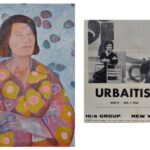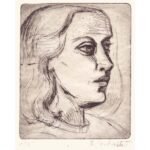
Urbaitis Elena
Elena Urbaitytė (born June 4, 1922, Kaunas – died February 17, 2006, New York) – Lithuanian artist, sculptor.
Born into the family of Ignas Urbaitis (1896-1952), a Lithuanian army officer, later a political and public figure, and a lawyer. Mother Elena Bražionytė (1899-1990), daughter of Juozas Bražionys, head of the horse farm of the Russian Tsar Nicholas II’s palace. Brothers pedagogue Algirdas Urbaitis (1931-1987) and engineer constructor Liudvikas Urbaitis (born 1933)
In 1941, she graduated from Šiauliai Girls’ Gymnasium, and on the day she received her certificate, the German-Russian war began. 1941-1943 studied at the Kaunas Institute of Applied and Decorative Arts, and when the Germans closed it, she returned to Šiauliai.
As the front approached, the family moved to Švėkšna, from where she was the only one in her family who managed to escape to the West. She worked at a weapons factory in Czechoslovakia, later moved to Vienna, where she experienced American bombing. She lived out the war in a village near Salzburg. She made a living by painting portraits of people for food. When the town was occupied by the US army, she made her way to Munich, where she entered the art academy, which was relocated to Heimhausen. In 1947, she moved to Freiburg in the French occupation zone, where Vytautas Kazimieras Jonynas established the School of Applied Arts. In 1949, she won a scholarship to continue her art studies in Paris, and later a Bachelor of Arts scholarship at Alabama College in the USA (now the University of Montevallo).
From 1953 lived in New York, worked as a teacher from 1957 to 1984, studied at Columbia University from 1958 to 1960. In 1961, she held her first painting exhibition at the Auth Shermen Gallery in New York, and later had 15 more solo exhibitions in New York (1961, 1962, 1963, 1978, 1979, 1980, 1982, 1984, 1987), Chicago (1967), and Toronto, and participated in over 100 group exhibitions in 21 museums and galleries in the United States. Her work was also presented by the Lithuanian Art Museum, the Museum of Applied Arts (1988 and 1997) in Vilnius, and the Mikalojus Konstantinas Čiurlionis National Art Museum in Kaunas (2000). [1]
1976 visited Lithuania for the first time. In her will, she divided her work between the Lithuanian Art Museum, the National M. K. Čiurlionis Museum and the Šiauliai Aušra Museum.
Awards:
1975 Hekšeris Museum Prize for great creative achievements.
1977 Lithuanian Cultural Center Gold Medal
1988 American Contemporary Art Association Sculpture Prize
1992-1993 International Biographical Center (Cambridge, England) Woman of the Year title
1993 American Lithuanian Cultural Council Main Prize for Creativity
2004 International Biographical Center International Visual Artist of the Year title
In her art, E. Urbaitytė sought to combine painting, sculpture and architecture. An example of this is her sculptural series called “Painted Surfaces” (1987) and “Installation” (1990) – works created in a mixed media, exhibited at Long Island University. Since 1979, the artist has devoted herself entirely to sculpture, her first results were shown at the Phoenix Gallery, called “Illuminated Construction”. Color in painting was her most important tool, and when transferred to sculpture, it turned into a giant installation or montage.
The almost 84-year-old sculptor left most of her works to Lithuanian museums. They can also be seen in open spaces in Vilnius and elsewhere: “Space Flight” (1992) is near the Press House, “Reflections” (1996) – in Europos Parkas, five sculptures from the series “Steel Now” (1997) – in the courtyard of the Technical University Library in Vilnius, etc. A small portion of her archives and several works of art will remain with ALKA in Putnam and the World Lithuanian Center in Lemont.



